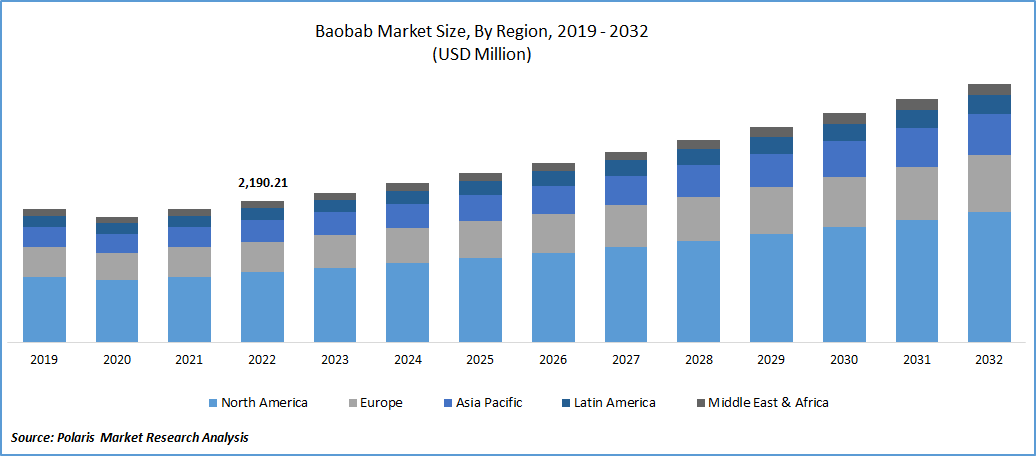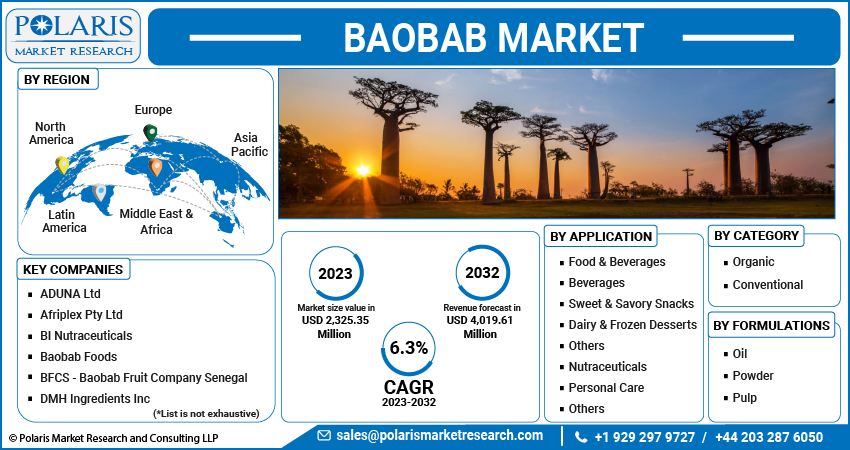
Baobab Market Share, Size, Trends, Industry Analysis Report
By Category (Organic, and Conventional); By Formulations; By Application; By Region; Segment Forecast, 2023 - 2032
- Published Date:Jul-2023
- Pages: 114
- Format: PDF
- Report ID: PM3624
- Base Year: 2022
- Historical Data: 2019-2021
Report Outlook
The global Baobab market was valued at USD 2,190.21 million in 2022 and is expected to grow at a CAGR of 6.3% during the forecast period. The baobab tree is distinguished by its enormous size and exceeded trunk. Due to its nutritional and therapeutic qualities, it is produced in various African locations and is becoming increasingly well-known worldwide. Protein, carbohydrates, energy, fiber, as well as vital vitamins and minerals, are all found in abundance in baobab. Because baobab powder is so rich in minerals, including potassium, dietary fibers, calcium, iron, and magnesium, the demand for healthy foods and beverages is driving up demand for and consumption of the product. It is the greatest place to buy supplements for health.

To Understand More About this Research: Request a Free Sample Report
Baobab powder is also widely used in the sports industry since it helps athletes get the nourishment they need. This positively impacts the baobab powder market and allows the food and beverage sector to thrive. Functional beverages can also be made with baobab fruit and powder. The fruit has a naturally sweet and savory flavor that suits customers of all ages. Due to the powder's high vitamin content, nutraceutical products also use it. Due to their lack of gluten, baobab extracts have a greater appeal to consumers.
However, more than 300 traditional uses of baobab have been documented, including fruit pulp, baobab leaves, powdered seeds, and more. There are many opportunities for new products to enter the market. The current demand for natural or organically derived items is only one example of how global trends, regardless of the location of origin, are being adopted by internet culture.
However, Baobab ingredients are more expensive because baobab harvesting, logistics, and processing demand significant effort. The abundance of available replacements for baobab, such as camu camu fruit, guava fruit, and acerola cherries, is a significant inhibitor to the expansion of the baobab ingredient industry. The COVID-19 pandemic has raised consumer demand for goods that boost immune function and general health. Due to the product's nutritional profile, this presents opportunities for baobab exporters. Despite the low consumer awareness of baobab, European brands and exporting companies have developed initiatives to raise it.

For Specific Research Requirements, Request for a Customized Report
Industry Dynamics
Growth Drivers
The demand for baobab extracts is increasing in the personal care sector, greatly aiding the market's expansion. Due to the baobab's health benefits and the rising demand for organic personal care products, it has experienced significant growth in the last few years. Nutritive compounds found in cosmetics made from baobabs aid in skin calming and dermis protection. To ensure protection against inflammatory phenomena, it helps to restore the smoothness of hair and skin. It is suitable for anti-aging skin care, after-sun skin care, moisturizing skincare, and restructuring hair care.
Further, the market's growth would be boosted by rising demand for organic cosmetic and personal care products during the forecast period. For instance, in March 2022, RonaCare Baobab, a natural active ingredient from Merck KGaA, protects skin structure and lessens redness. RonaCare Baobab, made from the pulp of the baobab fruit, naturally protects the skin. It provides the option of a calming skin sensation while preserving the skin structure to maintain firmness and elasticity. These benefits of baobab for personal care and product launches by the manufacturers for skin care are boosting the baobab market growth over the forecast period.
Report Segmentation
The market is primarily segmented based on category, formulations, application, and region.
|
By Category |
By Formulations |
By Application |
By Region |
|
|
|
|
To Understand the Scope of this Report: Speak to Analyst
Food and beverages segment is expected to witness the fastest growth during the forecast period
The food and beverage segment is quickly gaining popularity in various sectors, including nutraceuticals and personal care. Further, consumption is anticipated to increase in the coming years due to this plant's distinctive qualities and health benefits. Due to the rising demand for healthy and useful beverages, beverage industry manufacturers are highly motivated to include baobab in their product lineup. Due to growing concerns about bone health and nutritional deficiencies among older population groups, customers have become more drawn to healthy drinks.
Additionally, this region has a significant amount of government funding, which is likely to increase its participation in the food sector. The need for baobab powder as a natural ingredient for blending into juices and smoothies has grown due to growing awareness of nutritional deficiencies and a rise in the consumption of fruits and vegetables. Due to this product's high nutritional content, which includes vitamins A, C, and E, as well as minerals like calcium pantothenate that support the development of teeth and stronger bones in children under the age of 12, respectively, food companies are increasingly using it as a main ingredient.
The powder segment dominated the market in 2022
Due to its many potential applications, the powder market is expected to continue to dominate. Flour is used to flavor and combine foods and beverages. The longer shelf life of this powder makes it preferred. The biomass is produced from organic materials like fruit peels, agricultural waste, and animal dung to create the powder, a dry, granular form of biomass. Baobab powder is highly sought after in the global market for renewable energy because of qualities like low carbon emissions during combustion and effective thermal storage. It can be used to create biofuel pellets or liquid fuels, such as biopetroleum, which have uses in producing electricity or as a transportation fuel. More people than ever are interested in their diets, driving up demand for healthy food options.
Furthermore, Oil is a clear, supple liquid made from a specific tree's fruit pulp. Fatty acids are present in the Oil and are crucial to human health. Baobab oil has an excellent nutritional profile and can replace coconut oil in various cooking and baking applications. Due to its anti-inflammatory qualities, it also considers its use in skincare items to assist in reducing redness and irritation brought on by skin diseases like acne or eczema. Therefore, baobab in oil and powder form is in high demand for its health benefits as well as for its skin benefits that, are driving the segmental growth of the market.
The organic baobab sector is expected to hold a significant revenue share during the forecast period
The organic baobab segment is expected to hold its largest share owing to the rising demand for organic products in recent years due to its health benefits. Organic Baobab Powder is a natural food additive from the baobab tree's pulp. Organic baobab powder contains a variety of vitamins, including vitamins B1, B2, and C, as well as amino acids, which, among other things, promote bone health, weight loss, and muscle mass development. Additionally, the conventional baobab is made from the fruit of the African-native baobab tree. The tree produces large, rounded fruits with pulpy, dry flesh. This pulp is turned into a powder and used as a food additive or dietary supplement. This baobab powder is typically offered online or in health food stores.
The demand in Europe is expected to witness significant growth during the forecast period
Europe is anticipated to dominate the baobab market. The high consumer preference for functional beverages is one of the main factors boosting the baobab market in this area. Since there is a rising need for supplements and ingredients with high nutrient content and antioxidant capabilities, Europe is a lucrative market for baobab. More consumers are looking for goods that improve their general health. However, a lack of consumer knowledge of baobab and its associated health advantages hinders the market for the fruit.
The powder from a baobab tree has been linked to several health advantages. It is frequently marketed as a European supplement that promotes immunological health, boosts energy levels, and enhances digestive and overall health. Although some businesses, like the Dutch company Bao-Med, sell baobab powder in capsules, it is mostly sold as a fruit powder. Since there is a small market for uncertified baobab in Europe, most baobab powder is organically certified.
Additionally, contributing significantly to the global baobab market, North America is anticipated to grow at the highest rate during the forecast period. Due to the increasing demand for natural goods with low calorie and sugar content, the region's consumption is expected to increase significantly throughout the projection period. The market is expanding primarily due to rising consumer demand from food producers for natural and healthy ingredients.
A significant increase in this region will also be aided by growing consumer awareness of the product in Asia-Pacific. Africa is the primary producer of baobabs in the rest of the world and accounts for a significant portion of the global baobab market due to its long history of baobab use. Additionally, this region is consuming more products due to rapid urbanization and increasing consumer awareness of the product's health benefits, such as improved bone well-being and cancer prevention.
Competitive Insight
Some of the major players operating in the global market include ADUNA Ltd., Afriplex Pty Ltd., BI Nutraceuticals, Baobab Foods, BFCS - Baobab Fruit Company Senegal, DMH Ingredients Inc., EcoProducts, Halka B Organics, Henry Lamotte OILS GmbH, Indigo Herbs Limited, Mighty Baobab Limited, Nexira, NP Nutra, Organic Burst Uk Ltd., Organic Africa, Powbab, Inc., and Woodland Foods.
Recent Developments
- In January 2020, Baobab fruit supplier launched two new product innovations for beverages: Red Baobab tea and Ready-to-use Baobab paste.
Baobab Market Report Scope
|
Report Attributes |
Details |
|
Market size value in 2023 |
USD 2,325.35 million |
|
Revenue Forecast in 2032 |
USD 4,019.61 million |
|
CAGR |
6.3% from 2023 - 2032 |
|
Base year |
2022 |
|
Historical data |
2019 - 2021 |
|
Forecast period |
2023 - 2032 |
|
Quantitative units |
Revenue in USD million and CAGR from 2023 to 2032 |
|
Segments Covered |
By Category, By Formulations, By Application, By Region |
|
Regional scope |
North America, Europe, Asia Pacific, Latin America; Middle East & Africa |
|
Key Companies |
ADUNA Ltd., Afriplex Pty Ltd., BI Nutraceuticals, Baobab Foods, BFCS - Baobab Fruit Company Senegal, DMH Ingredients Inc., EcoProducts, Halka B Organics, Henry Lamotte OILS GmbH, Indigo Herbs Limited, Mighty Baobab Limited, Nexira, NP Nutra, Organic Burst Uk Ltd., Organic Africa, Powbab, Inc., and Woodland Foods. |
FAQ's
The global Baobab market size is expected to reach USD 4,019.61 million by 2032.
Top market players in the Baobab Market are ADUNA Ltd., Afriplex Pty Ltd., BI Nutraceuticals, Baobab Foods, BFCS - Baobab Fruit Company Senegal.
Europe contribute notably towards the global Baobab Market.
The global Baobab market expected to grow at a CAGR of 6.3% during the forecast period.
The Baobab Market report covering key are category, formulations, application, and region.
